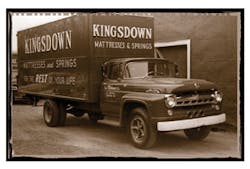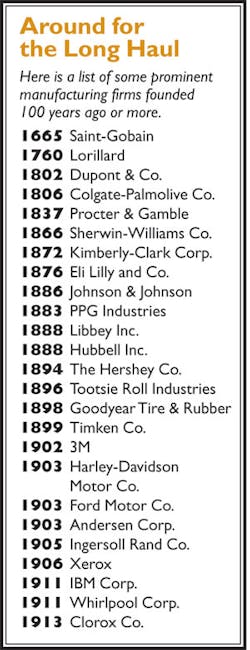Staying Power: Manufacturers that Stand the Test of Time
The Clorox Co. turned 100 earlier this year. Originally making a single product -- liquid bleach -- for industrial customers, the $5.5 billion manufacturer now produces a diverse range of products running the gamut from Kingsford charcoal to Burt's Bees face and body products. In May, in recognition of its centennial achievement, members of the Clorox Co.'s leadership team were invited to ring the opening bell at the New York Stock Exchange.
Harley-Davidson Motor Co. (IW 500/183) has 10 years on Clorox (IW 500/188). The Milwaukee-based motorcycle manufacturer is celebrating its 110th anniversary in 2013 with a year-long extravaganza that engages its devoted fan base in cities and events across the globe.
See Also: Lean Manufacturing Leadership Best Practices
And at more than 175 years old, the venerable Procter & Gamble (IW 500/12) remains the type of company to which many businesses aspire.
These companies are seemingly exceptions to a trend of decreasing business longevity, however. Lifespans of companies are shortening, concludes a recent Innosight study of the S&P 500 index. The consulting firm's research showed that in 1958, the average tenure of a company in the S&P 500 index was 61 years. The average had dropped to about 25 years by 1980 and was down to 18 years in 2012.
Why, then, do some manufacturers display remarkable staying power for 100 years or more, while others cease to exist? Are there characteristics in common among firms that last?
Evidence provided by time-tested manufacturers and the researchers and analysts who study them suggest the answer is "yes" in many instances. Companies that stand the test of time are able to do so because they change with the times. Moreover, while these long-lasting companies may make a misstep from time to time, or pull back in the face of harsh economic conditions, they also demonstrate a resiliency that not all manufacturers can mimic.
Adapt or Say Goodbye
"First and foremost, having a product or having a service that continues to adapt to meet the needs of customers is going to be paramount to making a company successful in the long-term," says Michael Zinser, a partner in the Boston Consulting Group.
It seems an obvious first step, but for many companies it is not. Ask Lee Schwartz, principal and founder of the Schwartz Profitability Group.
He describes a past engagement with a manufacturing client that at one time made a product Schwartz described as the "Cadillac" of its high-tech industry. The product not only was the best available, but it also had little competition. The product line served as the foundation of the company's revenue.
"Unfortunately, as technology improvements came to market, they didn't change with the times," Schwartz said. "They lost sight of the target. Their core product line became obsolete. Companies with greater vision entered the marketplace using the newer technology. Long-term customers found alternative products and/or sources of supply. They lost that stream of reliable revenue and haven't been able to find a replacement."
They continue to struggle still today, he said. "Will they reach 100 years? They're working on it."
Customer First
Frank Hood's company, on the other hand, is all about the customer. Hood is president and CEO of Kingsdown Inc., a Mebane, N.C., mattress and bedding manufacturer whose history dates back to 1904. It is a small ESOP (employee stock ownership plan) company with five U.S. factories.
Nevertheless, in the wake of challenges presented by the recent recession, change at Kingsdown has become a constant in recent years. Hood expects it to remain so. "You have to be prepared to change, not only in the way you think, but in how you lead and in the products that you offer," he says.
For Kingsdown, creating a sustainable future means growing its customer base and deepening ties with its retailers. To that end, the manufacturer's recent changes include expanding its product portfolio. Kingsdown has developed bedding for all segments from luxury to value, and it is venturing into additional international markets. This year the manufacturer also introduced what may be the most high-tech of beds: fully automatic and able to continuously adjust based on changes such as movement and pressure.
"Our retailers are going to have a product that nobody else can make," Hood says.
Even more, those Kingsdown retailers have access to the manufacturer's electronic selling process. The computerized diagnostic process takes a scientific approach to recommending bedding choices to potential purchasers. While it's a Kingsdown process, recommendations can direct purchasers toward any of the beds carried by the retailer.
There was "blasphemy in the boardroom" when the idea of recommending competitors' products was introduced, Hood said. However, the goal warrants the bold move, he says.
"Our goal was to inculcate, ingrain ourselves into the retailers' selling process," he said. "We're going to raise the tide of everybody's products on the floor, and we're going to get our fair share."
Organizational Ambidexterity
Charles O'Reilly, a professor in the Stanford University Graduate School of Business, extends an alternate theory to explain business longevity. He calls it "organizational ambidexterity," defined as "the dynamic capability of an organization to simultaneously explore and exploit."
In other words, organizational ambidexterity is the ability of an company to simultaneously pursue or "exploit" its current business while "exploring" new areas for growth. Companies that demonstrate an ability to do both are more likely to last longer, O'Reilly suggests.
The professor cites the example of IBM Corp. (IW 500/10), which reached the century mark in 2011. In research conducted with Harvard University's J. Bruce Harreld and Michael L. Tushman, O'Reilly detailed IBM's Emerging Business Opportunities initiative, a development that arose in 2000 in response to unsatisfactory efforts by IBM to commercialize new technologies, according to the scholars. Several root causes of that failure were attributed to IBM's pursuit of the new opportunities using the same tools that delivered the company success in its mature businesses.
"Armed with this understanding, the team realized that what was needed was an explicit system that provided for the founding, development, and leadership of new growth opportunities," they note in "Organizational Ambidexterity: IBM and Emerging Business Opportunities."
The new initiative delivered success. EBOs added $15.2 billion -- or 19% -- to IBM's top line between 2000 and 2005, the researchers wrote.
Tracking Trends
Like Kingsdown, the Clorox Co. identifies a wealth of contributors to its long-term success. A fast start is not one of them. Initially known as the Electro-Alkaline Co., Clorox nearly collapsed shortly after it began when founders who knew how to manufacture didn't bring the same skill to marketing their product. The tide turned when a young couple, who also were early investors in the fledgling operation, "came to the rescue," according to Clorox. The husband helped streamline operations while his wife conceived the idea to market Clorox liquid bleach to homemakers. Still, for its first 56 years, Clorox remained a one-product company.
It is far from that today. Growth has arrived via acquisition, such as its fiscal 2010 purchase of Caltech Industries, and organically, including the launch of Green Works natural cleaning products.
Where Clorox may differ from other firms, however, is the deliberate nature of its growth. The company says the choices it has made to strengthen its portfolio have been in response to global trends in specific areas, including health and wellness and sustainability.
"Staying [atop] those trends has helped keep the brands relevant," said Clorox Chairman and CEO Don Knauss in an interview with NYSE Euronext.
It's Not Only About Change
Boston Consulting Group partner Michael Zinser highlights additional factors he believes contribute to the ability of a company to achieve longevity. They include:
1. An experienced and committed management team. As well, "You certainly want a management team that is able to adapt, one that understands the trends that are impacting the marketplace and are able to capitalize on those trends," he says.
2. A supply chain with built-in flexibility. Zinser says a flexible supply chain has the ability to respond to shocks in the marketplace. It can scale up or scale down as needed. Additionally, a supply-chain with built-in flexibility can respond to changes in where demand is coming from and how to address it.
3. A continuous improvement mind-set. Companies that last typically engage in continuing efforts to improve the productivity of their operations. Such efforts may relate to driving down costs, improving quality or continuously adapting to meet the delivery demands of their customers.
"You see this in spades with companies like Toyota. Your see it with Procter & Gamble," Zinser says. "It is that ongoing ability to drive productivity and continuous improvement in their operations."
4. An ability to engage and empower the workforce. Zinser describes a workplace in which employees feel good about the work they do. They believe the firm is investing in them, as well as providing opportunities to contribute to the organization's success.
"We find those companies that are able to create that loyalty and engagement [are] able to withstand a lot of external shocks and work together to keep the business going," Zinser says.
|
Go online to www.iw.com/century-manufacturers to view a slideshow of manufacturing companies that have achieved or surpassed the century mark. |
Ultimately, a strategy to drive longevity can't be jotted down on a Post-it brand notepad or Top 10 list.
"There are a lot of moving pieces that need to line up for a company to be successful," says Zinser.







